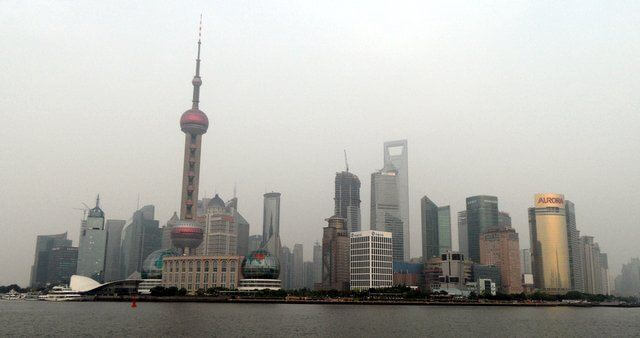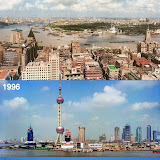
Shanghai is the most developed city in China, growing massively over the last ten years to a population of nearly nineteen million people. At the turn of the 19th century Shanghai was still divided between China and the 8-nation Alliance consisting of Germany, France, Italy, Russia, Austria-Hungary, Japan, the United States and the United Kingdom. Each country was granted a concession until the Japanese occupied the city during the Second World War, but these areas still exist today, with British style buildings on the Bund, French inspired areas and 1930’s building reminiscent of New York.
Now Shanghai is competing with Hong Kong to become the major financial centre of both China and Asia. Despite Hong Kong’s experience and expertise, Shanghai is pulling ahead due to its location on the mainland and stronger links with the government.
All this growth has brought in a huge expat community, which is evident from the number of Western restaurants and brands that have opened stores in town, leaving it all feeling somewhat unlike any other Chinese town, except maybe Hong Kong. There are still Chinese restaurants, and the Shanghainese cuisine is wonderful, but all the best rated eateries are French and Italian.
Probably due to the high number of foreigners in town, there is a lot more English in evidence than in Beijing, from subway signs to restaurant menus, and a lot more of the Chinese here are proficient in spoken English. It’s very helpful for learning Chinese as I can finally begin to understand some of the more common Chinese characters when the (approximate) English translation is alongside. To counter this usefulness the cities inhabitants speak their own language, also called Shanghainese which is unintelligible to Mandarin or Cantonese speakers.
Shanghai is a huge town, but aside from the two days at the World Expo we spent our time in the most tourist-laden areas; Nanjing Road, the Old City, the Bund and Xintandi in the French Concession.
Nanjing Road East runs from the People’s Square, with the Shanghai Grand Opera Palace and Shanghai Museum, all the way to the Bund on the waterfront. Nanjing Road East is an area of smaller shops and restaurants unlike Nanjing Road West which is far more upmarket and has large branches of luxury goods stores such as Porsche and Louis Vuitton, with prices equivalent to any Western city. There’s also a large pedestrian area joining the two roads into an overwhelming 6km long shopping strip. It’s also filled with touts for a fake goods store just off the main strip – they approach you constantly, sometimes two or three at once and can get quite annoying when they start following you into shops or sitting next to you on park benches. Asking around the goods they sell are utter rubbish, as you might expect when offered an iPhone for £40.
The Old City is the original walled off area of Shanghai that was kept exclusively Chinese during the era of foreign concessions. Now it’s a tourist trap for foreign and Chinese alike, and the small traditional buildings now house shops selling silks, chopsticks, wood carvings and clothes. The main attraction seems to be our main destination, the Xiaolongbao soupy dumpling shop. This is a small two storey restaurant that sells nothing but one flavour of soupy dumplings and a light broth in place of any drinks. Everyone is lumped together and sits with strangers round a table for six. The dumplings are minced pork with a hint of shrimp, wrapped in light dough. As they cook in bamboo steamers the pork fat melts and creates a delicious soup trapped inside the dough. Served with a bowl of vinegar and ginger to cut through any fatty taste these are a bit of a nightmare to eat with chopsticks.
- First you need to pick the dumpling up gently enough not to break the dough and squirt hot soup over your neighbour.
- Then you need to bite a small hole in the top of the dumpling without applying enough pressure to squirt hot soup all over your neighbour.
- Now it’s time to suck the soup out of the dumpling without burning your mouth and squirting hot soup all over your neighbour
- Then it’s time to take the first bite into the dumpling. Hopefully the soup hasn’t made it too slippery to hold, leading to it falling into the serving bowl, splashing cold vinegar all over your neighbour
- The second bite is more exciting as you can dip the dumpling into the vinegar and ginger mix, thereby making a bigger mess to splash all over your neighbour.
- The third bite is the last and easiest as you can just push the remainder of the dumpling into your mouth and finally enjoy the delicate flavour whilst your neighbour takes all the napkins to wipe up the soup.
Xintandi is in the old French Concession, a heavily Western area with all sorts of bars and restaurants from back home. When we were there it seemed mostly full of Germans filling every bar and pub. After 3 weeks of eating gizzards and feet and dogs and donkeys it was exciting to see such known quantities as Paul’s the bakers and we gave in to the urge to go for a Pizza Express, or Pizza Marzano as it’s known in some countries. Whilst sitting in the street it became apparent this area was very popular with a high number of grey haired, pony-tailed white men dating Asian girls who looked around 16, which was rather uncomfortable. I had noticed this in Beijing, but it’s far more prevalent here and it’s no surprise there’s a bit of a backlash going on against foreigners in Shanghai at the moment.
We took Shanghai’s rather pleasant metro over to the far side of the Huangpu River and the financial centre of Pudong. After a quick visit to the Super Brands mall we wandered round the base of the oddly shaped Oriental Pearl TV tower, the 3rd tallest tower in the world, and the 492m Shanghai World Financial Centre, shaped like a bottle opened. The SWFC was intended to be the tallest building in the world, but has now been relegated to a poor 2nd by the 828m Burj Khalifa in Dubai. It does contain a Hyatt which can still claim to be the highest hotel in the world.
It’s possible to cross the river by ferry but is quick to go via the Bund Sightseeing Tunnel, which was atrocious. Admittedly it was quick, but the 672m journey costs an excessive ¥45 and is lit by embarrassing 80’s style special effects and made suspenseful by a series of unnecessary curtains. Strangely there was a strong smell of cheese in the tunnel, which seemed apt for the quality of the ride.
The street on the other side of the river is called the Bund and used to be the city’s financial district until Pudong took the mantel. It’s now home to some of the city’s best restaurants and a thronging crowd waiting for sunset and the spectacular lights of the new skyscrapers, which in just 15 years have replaced the farmland on the opposite banks.






